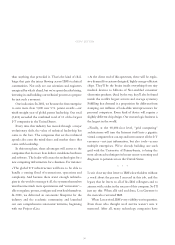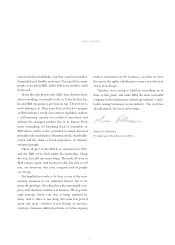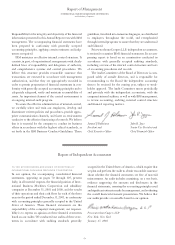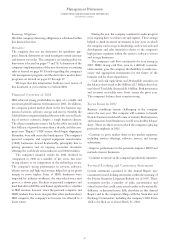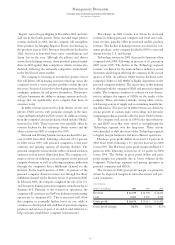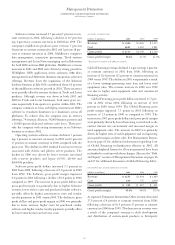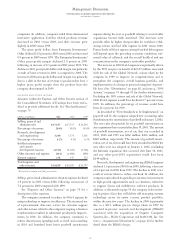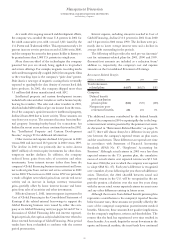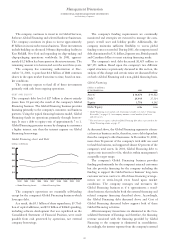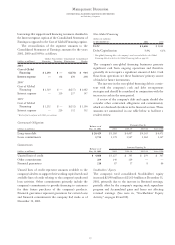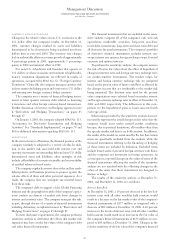IBM 2001 Annual Report Download - page 61
Download and view the complete annual report
Please find page 61 of the 2001 IBM annual report below. You can navigate through the pages in the report by either clicking on the pages listed below, or by using the keyword search tool below to find specific information within the annual report.
“Regatta” servers began shipping in December 2001, and were
sold out in the fourth quarter. Entry and mid-range pSeries
revenue declined in 2001, but the company will strengthen
these products by bringing Regatta’s Power-4 technology to
the products later in 2002. Revenue from iSeries declined in
2001; however, it benefited from server consolidations and
Linux late in the year. Although the pSeries and iSeries
servers had declining revenue, these products gained market
share in 2001 against their competitors. xSeries revenue also
declined, reflecting the extremely competitive environment
in the Intel-based server market.
The company is investing in an initiative (project eLiza)
that will deliver self-managing systems technology across the
company’s entire e-server product portfolio within the next
five years. Project eLiza involves developing systems that can
configure, optimize, fix and protect themselves. This project
will give businesses the ability to manage systems and tech-
nology that are significantly more complex than those in
existence today.
In 2000, revenue increased for both xSeries servers and
pSeries UNIX servers, with particular strength in the mid-
range and high-end pSeries Web servers. In addition, revenue
from the company’s storage products, which include “Shark,”
increased in 2000. These increases were partially offset by
revenue declines for the mid-range iSeries servers and the
zSeries servers in 2000 as compared to 1999.
Personal and Printing Systems revenue declined 20.6 per-
cent in 2001 from 2000, following a decrease of 3.2 percent
in 2000 versus 1999 with personal computers, retail store
solutions and printing systems all showing declines. The
personal computer revenue decline reflects demand weakness
and price erosion across all product lines. The company con-
tinues to focus on reducing cost and expense in the personal
computer business as well as achieving maximum utilization
through the company’s direct fulfillment channel via the
Internet. In the fourth quarter of 2001, 44 percent of the
personal computer division revenue was through the direct
fulfillment channel via the Internet versus 34 percent in 2000.
In February 2002, the company completed the sale of its U.S.
and European desktop personal computer manufacturing to
Sanmina-SCI. Pursuant to the transaction agreement, the
company will outsource its NetVista desktop manufacturing
operations to Sanmina-SCI. This transaction will allow
the company to eventually further lower its cost, while it
continues to develop and sell a full line of personal computer
products and services as part of its end-to-end solutions to
help customers build their computer infrastructure.
The change in 2000 revenue was driven by decreased
revenue in desktop personal computer and retail store solu-
tions revenue, partially offset by increased mobile products
revenue. The decline in desktop revenue was driven by con-
sumer products, as the company decided in 1999 to exit retail
channels in the U.S. and Europe.
Technology revenue in 2001 decreased 6.4 percent when
compared with 2000, following an increase of 6.1 percent in
2000 versus 1999. The decline in the Technology segment
revenue was driven by the semiconductor industry’s severe
downturn which began affecting the company in the second
quarter of 2001. In addition, HDD revenue declined as the
company’s ability to sell HDDs is highly dependent on the
personal computer industry. The uncertainty in this industry
is affecting both the company’s HDD and personal computer
results. The company continues to evaluate various alterna-
tives to mitigate the impact of HDDs on the results of the
company. These alternatives include, among other actions,
rebalancing sources of supply and re-examining manufactur-
ing efficiencies. The increase in 2000 revenue was driven by
strong growth in custom logic, networking and pervasive
computing products, partially offset by lower HDD revenue.
The company took actions in 1999 in the microelectron-
ics and HDD areas that were aimed at strengthening the
Te chnology segment over the long-term. Those actions
were intended to shift the focus of the Technology segment
to higher margin businesses and more efficient operations.
Hardware gross profit dollars decreased 13.8 percent in
2001 from 2000, following a 4.3 percent increase in 2000
versus 1999. The Hardware gross profit margin declined 0.7
points in 2001 following an increase of 1.2 points in 2000
versus 1999. The decline in gross profit dollars and gross
profit margin was primarily due to lower volumes in the
company’s Technology segment and pricing pressures in
personal computers and HDDs.
The increase in 2000 gross profit margin was primarily
driven by improved margins in microelectronics and per-
sonal computers.
SOFTWARE
(dollars in millions) 2001 2000 1999
Revenue $«12,939 $«12,598 $«12,662
Cost 2,265 2,283 2,240
Gross profit $«10,674 $«10,315 $«10,422
Gross profit margin 82.5% 81.9% 82.3%
Management Discussion
INTERNATIONAL BUSINESS MACHINES CORPORATION
and Subsidiary Companies
59



